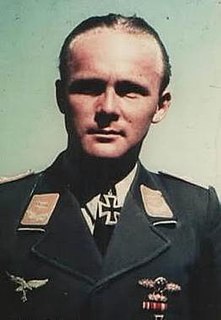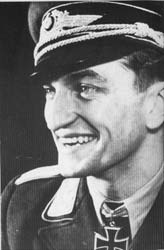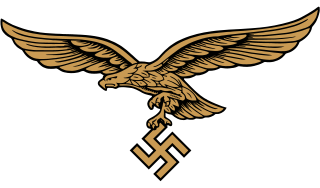
Hubertus von Bonin was a German Second World War fighter ace who served in the Luftwaffe. A flying or fighter ace is a military aviator credited with shooting down five or more enemy aircraft during aerial combat. Bonin is credited with shooting down 77 enemy aircraft. The majority of his victories were claimed over the Eastern Front. He also claimed four victories in Spain during the civil war. His commands included Geschwaderkommodore of Jagdgeschwader 54.
Anton Mader was a German pilot during World War II. He claimed 86 victories and was a recipient of the Knight's Cross of the Iron Cross. He held commanded fighter wing Jagdgeschwader 54 in 1944.
Max Ibel is credited as one of the creators of the Luftwaffe. He was also a recipient of the Knight's Cross of the Iron Cross.

Franz-Josef Beerenbrock was a German fighter pilot during World War II. He was a recipient of the Knight's Cross of the Iron Cross with Oak Leaves. Beerenbrock was credited with 117 aerial victories in approximately 400 combat missions, all on the Eastern Front. In November 1942 he became a prisoner of war for the rest of the war.

Hans Götz was a former Luftwaffe fighter ace and recipient of the Knight's Cross of the Iron Cross during World War II. Hans Götz was credited with 82 victories in 600 combat missions. He claimed three victories over the Western Front.
Herbert Bareuther was a World War II fighter ace from Nazi Germany. He was born on 29 July 1914 at Asch in Egerland. Bareuther was credited with having shot down a total of 55 enemy aircraft. All the victories he achieved were recorded over the Eastern Front.

Heinz Wernicke was a Luftwaffe World War II fighter ace and was credited with 117 aerial victories—that is, 117 aerial combat encounters resulting in the destruction of the enemy aircraft. He was also a recipient of the Knight's Cross of the Iron Cross, the highest award in the military and paramilitary forces of Nazi Germany during World War II. Wernicke was killed in a mid-air collision with his wingman on 27 December 1944.
Gerhard Hoffmann was a Luftwaffe flying ace of World War II credited with 130 shootdowns. He was also a recipient of the Knight's Cross of the Iron Cross.
Walter Borchers was a German Luftwaffe military aviator and wing commander during World War II. As a flying ace, he was credited with 59 aerial victories, including 43 nocturnal victories, 10 as a destroyer pilot and 6 four-engined bombers at day time, claimed in roughly 300 combat missions. Prior to his death he held the position of wing commander of the 5th Night Fighter Wing.
Alfred Teumer was a Luftwaffe flying ace during World War II and recipient of the Knight's Cross of the Iron Cross. The Knight's Cross of the Iron Cross was awarded to recognise extreme battlefield bravery or successful military leadership. He is credited with 76 aerial victories claimed in over 300 combat missions.

Konrad Bauer was a Luftwaffe fighter pilot during World War II and a recipient of the Knight's Cross of the Iron Cross. Bauer claimed 57 aerial victories, 39 over the Western Front and 18 over the Eastern Front.
Ernst Börngen was a Luftwaffe ace and recipient of the Knight's Cross of the Iron Cross during World War II. The Knight's Cross of the Iron Cross was awarded to recognise extreme battlefield bravery or successful military leadership. Börngen claimed 41 victories in 450 missions.
Walter Brandt was a German Luftwaffe ace and recipient of the Knight's Cross of the Iron Cross during World War II. The Knight's Cross of the Iron Cross was awarded to recognise extreme battlefield bravery or successful military leadership. Walter Brandt was credited with 43 aerial victories in 527 missions.
Franz Beyer was a German Luftwaffe fighter pilot during World War II and a recipient of the Knight's Cross of the Iron Cross of Nazi Germany. Beyer was killed on 11 February near Venlo, the Netherlands after dog-fighting with British Spitfires. During his career he was credited with 81 aerial victories, 4 on the Western Front and 77 on the Eastern Front. On 1 June 1943, Beyer was appointed Gruppenkommandeur of IV. Gruppe of Jagdgeschwader 3.
Erich "Schmidtchen" Schmidt was a Luftwaffe ace and recipient of the Knight's Cross of the Iron Cross during World War II.
Herbert Kutscha was a German Luftwaffe fighter ace and recipient of the Knight's Cross of the Iron Cross during World War II. The Knight's Cross of the Iron Cross was awarded to recognise extreme battlefield bravery or successful military leadership. He was one of few Luftwaffe pilots to survive the whole war, serving from 1939 until 1945. During his career he was credited with 47 aerial victories in more than 900 missions.
Kurd Peters was a German officer (Major) in the Luftwaffe during World War II, and a recipient of the Knight's Cross of the Iron Cross of Nazi Germany. He was credited with four aerial victories in Defense of the Reich actions.
Bernd Gallowitsch was a German Luftwaffe ace and recipient of the Knight's Cross of the Iron Cross during World War II. The Knight's Cross of the Iron Cross was awarded to recognise extreme battlefield bravery or successful military leadership. Bernd Gallowitsch was credited with 64 aerial victories, and the destruction of 23 tanks in 480 combat missions.
Franz Hrdlicka was a Luftwaffe ace and recipient of the Knight's Cross of the Iron Cross during World War II. During his career Franz Hrdlicka was credited with 60 aerial victories.
Helmut Mertens was a German fighter ace of World War II. He was born in Essen and served in the Luftwaffe as a career fighter pilot who served in the Battle of France, Battle of Britain, the invasion of Russia Operation Barbarossa and on the Western Front in the Defence of the Reich. His victory tally as a fighter pilot is reported as high as ninety-seven or as few as fifty-four aircraft confirmed shot down.








